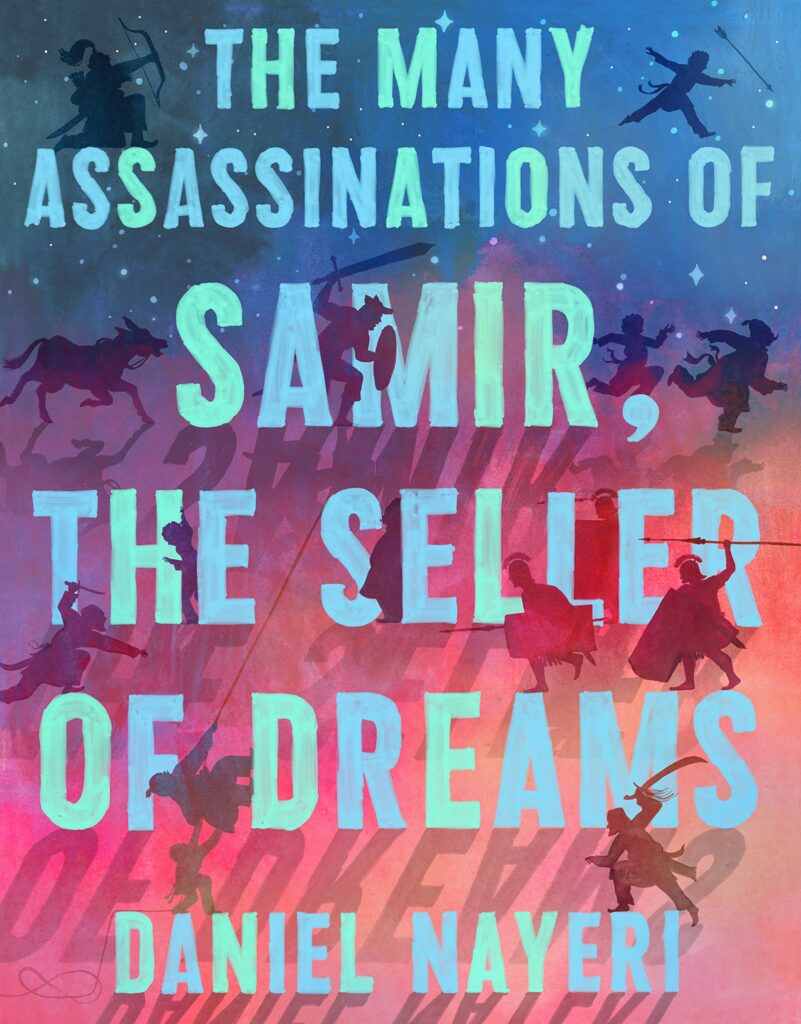The Many Assassinations of Samir, the Seller of Dreams by Daniel Nayeri: Betsy and Janie Discuss
Betsy: Janie, you and I both (eagerly) received advance reader copies of Daniel Nayeri’s newest book, The Many Assassinations of Samir, the Seller of Dreams. I’m not sure what I was expecting, but this book was delightful. It’s also quite different from our beloved Everything Sad Is Untrue. First, it’s not a memoir. It’s entirely fictitious. Second, the story moves more linearly, with chapter breaks, than did Everything Sad. We haven’t reviewed this title yet (it just came out last month!), so would you give our readers a synopsis of the story? But no spoilers! (Readers, this may be one of the most challenging titles we’ve ever reviewed simply because we don’t want to give away the ending.)

Janie: Sure! First of all, it’s unique. How to classify—is it historical fiction, as it takes place during a historical time and particular location? Or do the fantastical elements make it more of a fantasy? Is it a mystery, or a puzzle? And what to make of an opening sentence like this: “The first time I was stoned to death by an angry mob, I was not even a criminal”? Our narrator (who apparently has been stoned to death more than once!) is an orphan being raised by monks in the desert of northwest China, but those very monks have become the angry mob. Running away from them, he seeks refuge in a nearby merchant’s caravan, where an oily character named Samir bargains him away from the monks.
Samir names the orphan “Monkey,” and the two begin a journey along the legendary Silk Road. It turns out that Monkey’s new master is a confirmed liar who has made enemies everywhere he’s traded. His greatest enemy, a man in the same caravan whom Samir regards as practically family, has hired an array of assassins who lay in wait for him. And, by extension, for Monkey. The story is a journey narrative, with Samir encountering one threat after another, building up to the most intimidating of all, a notorious killer known as “Cid.”
That’s the outline, but it doesn’t begin to convey the quirky character of this novel. How would you describe it, Betsy? What sets this travel narrative apart from others—again, without giving anything away. Could you include an example or two?
What Sets The Many Assassinations of Samir, the Seller of Dreams Apart?
Betsy: One of my favorite parts of this book is the narrator’s voice. We know him as “Monkey” through most of the book, but his name is probably Omar. (I say “probably” because the name was given by a widow who informally adopted him after his parents died.) Sometimes, first-person narration can be grating and involve too much “telling” and not enough “showing.” But this story is ultimately about Samir, so, while Monkey does offer his own thoughts (and they’re both philosophical and funny), much of his narration is showing the reader who Samir is. Occasionally, he even speaks directly to the reader, as if he’s anticipating our reaction to his story. And, as you mentioned, Janie, he’s constantly alluding to future events with phrases like that first sentence: “the first time I was stoned to death….” By turn, Monkey’s self-deprecating, sarcastic, thoughtful, or humorous, as the situation demands. And through his voice, we begin to get a very clear picture of Samir, the smarmy salesman.
Another distinctive feature is the setting: the Silk Road winds through howling deserts, bustling trade centers, and all manner of cultures. It’s completely different from what we might experience here in America. And yet, Nayeri respects his readers too much to spell it all out for us. We have to pick up on the different cues to fully grasp what the places are like. Plenty of colorful details help readers picture a given scene, but we, as readers, have to put those moments together as the landscape and setting unfold.
Janie, what were some of your favorite scenes in the book?
Janie: The chess game with the ablutionist (poisoner) is a standout—lots of meat for philosophical musing! And I’d have to say, I love Samir’s dream-selling. The “dreams” are stories that just might be true, and the way he tells them makes everyone within hearing distance lean in and listen. At one point, Monkey tries to intervene and explain that none of what Samir is saying actually happened, but he doesn’t understand what his master is doing. As I was reading one of these, the thought occurred to me that Samir is calling things that are not as if they were (Romans 4:17), and by the end Monkey understands this. “Sometimes you tell a story the way Samir does, and then it goes and finds a way to become true.” Truth is a shimmering thing that may appear clearly to some people at some times, and other times hide in the dark. For all his roundabout ways of getting at truth, Samir knows it’s there to be found, while two other members of the caravan claim to be “accidentalists” who see no reality beyond life and death. Monkey wavers between faith and skepticism, but by the end he’s made a choice to believe.
But getting there is half the fun! Part of Monkey’s conundrum is that he wants to believe in love, but even expressing that desire gets him in trouble. (That’s the reason, near as I can tell, for the “first time I was stoned to death.”) Love, if it exists, is the bulwark between life and death that makes both worthwhile. But is it for real, or an illusion? Is Samir, the dealer in dreams, the one who truly understands real life? I see this as the theme of the story. What do you think, Betsy?
Thematic Elements in The Many Assassinations of Samir, the Seller of Dreams
Betsy: Janie, I’ve been struggling to put the theme of this book into words, but I think you’re onto something. Love is what makes life worth the living, and I think it’s both real and an illusion, depending on the person, the relationship, and/or the divine being to whom the person is looking for life’s value. Monkey spends much time pondering the nature of reality and divinity, both, alongside his musings over love. And different people in the book express love in different ways: is it romantic in nature? gruff and “tough love” in nature? tenderhearted? sacrificial and generous? protective? In some ways, I think Monkey comes to understand that love is all of those things and more. He also beings to understand that real love doesn’t put a material value on life.
Real life transcends reality, in many ways, and our stumblings along on this earth are an attempt to lean into the true life, don’t you think? The more closely we understand true love, the more we will understand real life, and the higher price we will be willing to pay for both real love and real life. Since this is fiction, Nayeri doesn’t come right out and say real/true life is only in Christ, but I think the story backs up that idea of sacrificial love. Think I’m on the right track?
Janie: Not only on the right track, but I think Nayeri makes it explicit in a certain scene where someone is willing to die in order that someone else might live. (That’s as close as I can get to the ending without giving too much away, but you asked for it.) There’s also an interesting reference to Jesus in reference to Samir’s flea-bitten old donkey Rostam—”a warhorse to Neptune, a pallbearer of the Nazarene.” Christ appears for those with eyes to see him, and I believe Nayeri does. Part of the joy of reading this book—and I read it twice!—is finding those Christ-touches.
One thing we should also mention is that the book is physically beautiful, with colorful and evocative paintings at the beginning of each chapter. The Author Note at the end sheds some light on the Silk Road history and geography and provides context for each of the hired assassins, all of which had some place in history, if their place in this story is slightly exaggerated!
Betsy: I read it twice, too! I had to after that ending!
Final Notes: It’s safe to say that we would give this a starred review, were we reviewing this book in our traditional format. It also works well as a read aloud, especially to a middle school age range. The only “considerations” we might add are that Monkey muses over many different religious and philosophical options (but, as we indicated, he seems to be on the right track by book’s end); he’s also fallen in love for the first time (although this, too, is resolved by the end of the book, and there is no romantic physical contact).
Readers, you may be interested in other book discussions we’ve had, particularly in our annual Newbery Buzz series. We discussed Nayeri’s Everything Sad Is Untrue in one of those. And, finally, if you’ve read The Many Assassinations of Samir, the Seller of Dreams, let us know in the comments!
We are participants in the Amazon LLC affiliate program; purchases you make through affiliate links like the one below may earn us a commission. Read more here.
Stay Up to Date!
Get the information you need to make wise choices about books for your children and teens.
Our weekly newsletter includes our latest reviews, related links from around the web, a featured book list, book trivia, and more. We never sell your information. You may unsubscribe at any time.
Support our writers and help keep Redeemed Reader ad-free by joining the Redeemed Reader Fellowship.
Stay Up to Date!
Get the information you need to make wise choices about books for your children and teens.
Our weekly newsletter includes our latest reviews, related links from around the web, a featured book list, book trivia, and more. We never sell your information. You may unsubscribe at any time.
We'd love to hear from you!
Our comments are now limited to our members (both Silver and Golden Key). Members, you just need to log in with your normal log-in credentials!
Not a member yet? You can join the Silver Key ($2.99/month) for a free 2-week trial. Cancel at any time. Find out more about membership here.
5 Comments
Leave a Comment
You must be logged in to post a comment.




I just ordered this book from the library! I loved Everything Sad is Untrue, so I’m looking forward to another of Nayeri’s books!
Haley,
It’s different from the first book, but you won’t be disappointed!
Oh, wonderful! I didn’t realize Daniel Nayeri had another book releasing this year! I’m so excited! Thank you for this insightful discussion.
I loved this book, and I, too, plan on reading it again soon, to get another perspective now that I know the ending! As a middle-school librarian, I think Nayeri’s books can be awfully challenging for readers in the age range he is targeting, but I LOVE a challenge! He is one of the most astonishing writers around today, and I really believe his books will be categorized as classics in decades to come.
We agree! I especially agree that he can be challenging, but he’s one of the few truly literary authors around for this age range, and kids do need a challenge.